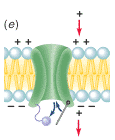The Refractory Period
Once the cell has repolarized after the action potential, the Na+ and K+ voltage-gated channels must reset, in preparation for another signal. While the inactivation particle (tethered plug) is in the Na+ voltage-gated channels, until it is removed and the activation gate is closed, the cell is in the absolute refractory period. This is because no more Na+ can travel into the cell to cause a depolarization and the transduction of a signal.
Once the K+ voltage-dependent channels have opened they remain open until the membrane potential reaches the equilibrium potential of K+. The membrane potential undershoots (is hyperpolarized from) its resting potential because the permeability of the cell is so high for K+, but no for other ions, so the cell potential will go to the equilibrium potential for K+ (which is below the resting potential).
While the K+ channels are open, the cell is in the relative refractory period.
Only a
very large depolarization will cause a signal, because as the Na+ flows in, in an attempt
to create an action potential, the K+ will flow out, short-circuiting the attempt. With
positive charge flowing in and out, only a very large stimulus will cause a depolarization
large enough to be registered.
 |
The activation gate is open and the inactivation plug is removed |